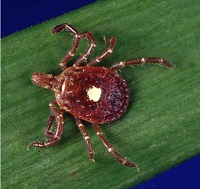Scientists in Florida have found a virus in ticks that is connected to hemorrhagic fever, which was thought to have disappeared globally more than 40 years ago.
 |
| A Lone Star tick--Courtesy of CDC |
Katherine Sayler, and other researchers from the University of Florida, discovered the Tacaribe virus in about 10% of the Lone Star ticks they collected at three state parks beginning in 2012. It is the first time the virus has been found in the U.S., the researchers said. Additionally, it is the first time the virus has been found to be carried by another species. Previously, the Tacaribe virus was only found in bats and mosquitoes.
"No arenavirus has ever been associated with a tick," Sayler told the Ocala Star Banner. Her findings were published in December in the journal PLOS ONE. "We need to do way more studies and secure funding to see if this virus is transmitted to people via tick bites and whether it causes hemorrhagic fever."
Initially, the virus was found in about 100 ticks collected in 2012 that when cultured indicated a genetic makeup that was 99.6% identical to the only remaining virus sample from Trinidad. The virus was first isolated from bats and mosquitoes during a rabies survey in that country during the late 1950s, and had not been seen since.
There is no known cure for hemorrhagic fever, which can include symptoms like fever, fatigue, weakness and muscle aches. Advanced symptoms can result in bleeding under the skin, in internal organs and from bodily orifices.
Recently, other rare viruses have come under scientific scrutiny. Researchers at the University of California, Davis, solved a century-old mystery when they discovered the bluetongue virus that affects cattle and sheep survives winter by reproducing in midges, which spread the virus.
Last month, researchers from Cornell University, Tufts University and the University of Georgia, as well as from the U.S. Fish and Wildlife Service and the U.S. Geological Survey, found the prime suspect in yearly mass die-offs of eider ducks in Cape Cod, MA, was a pathogen dubbed Wellfleet Bay virus (WFBV).
-check out the Ocala Star Banner story
-read the PLOS ONE abstract